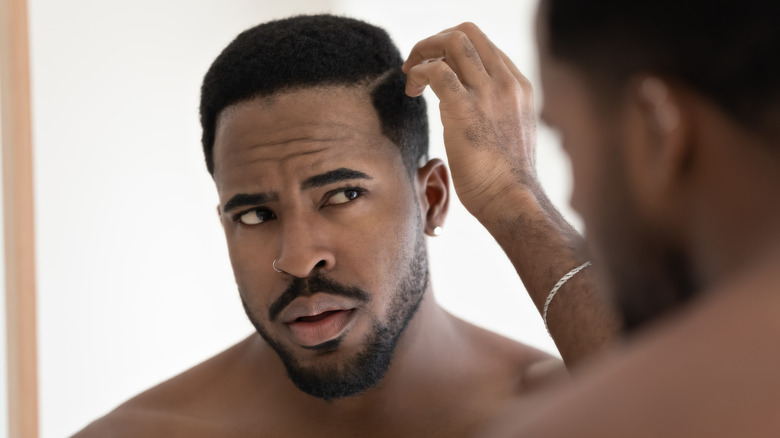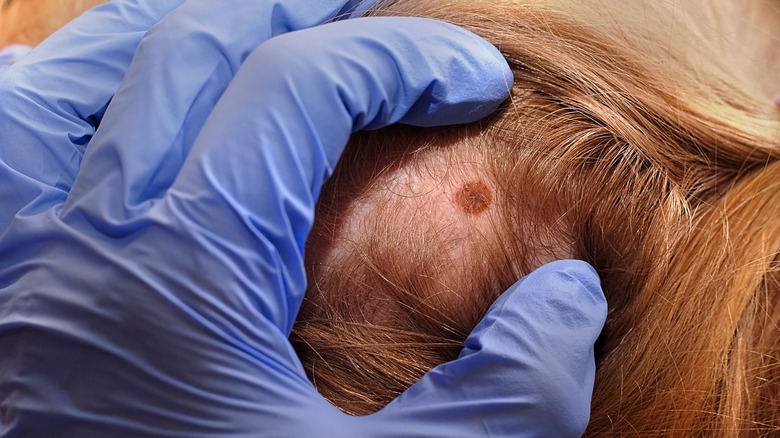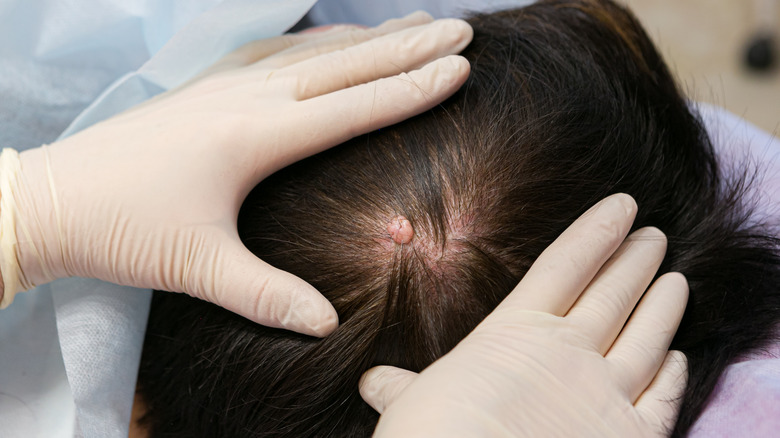What It Really Means When You Have A Mole On Your Scalp
Freckles, birthmarks, and moles, oh my! These are all marks that can be found on your skin, and you may notice the spots on your face and body, but have you checked your scalp lately? Just like the rest of your skin, there can be an array of marks and moles on your scalp.
Per ancient Chinese astrology, having a mole on your head is a sign that you will have lifelong good luck, according to Your Chinese Astrology. It has also been said that a mole on your forehead or head symbolizes confidence and success (via The Times of India). The thought of being successful, confident, and experiencing lifelong luck is exciting. However, it is important to be aware of the types of marks on your scalp so that you can monitor them responsibly and consult your healthcare provider when necessary. Here is what it really means when you have come across a mole on your scalp.
Common moles
Chances are that the moles on your scalp are completely normal, otherwise called common moles, according to Healthline. A common mole may also be called a nevus, and the average adult has between 10 and 40 common moles on their body. Common moles are typically 5 millimeters in diameter or less, and they usually appear in the shape of an oval or circle. A nevus can be raised or flat, and while some common moles are present at birth, others develop throughout the lifespan (via National Cancer Institute). Common moles are typically benign, though it is paramount to monitor them and take precautions when it comes to sun exposure.
To protect your skin, you should be mindful of sun exposure on your head and either apply sunscreen or wear a hat while outside. There are even sunscreen products made especially for protecting the skin on your scalp from harmful sun exposure (via Skin Cancer Foundation).
Monitoring moles
It is good practice to create a habit of checking your body on a regular basis for new moles and changes in existing moles. This includes your scalp, especially your hair part and areas that may not be regularly shielded from sun exposure. While many moles don't pose an issue, regular examination of the skin on your scalp will help you detect irregular moles and early development of melanoma, according to Healthline.
When monitoring a mole, it is advised to use the ABCDE method. The five characteristics to be mindful of are asymmetry, border, color, diameter, and evolution (via Healthline). This means that you should look for moles that have dissimilar sides and edges, borders of moles that are ragged or blurred, and different shades of color within the mole. Any mole that appears concerning should be checked out by a healthcare professional, but especially moles with diameters larger than 1/4 of an inch. It is also vital to monitor the moles you find on your scalp, which can be done by having another person examine your scalp and take photos so that you can monitor the evolution of moles you can't see yourself.
If you are concerned about a mole on your scalp or anywhere on your body, it is recommended to consult with your doctor. A specialist who focuses on treating conditions that affect the skin, including moles, is called a dermatologist.
Other types of bumps that can be on your scalp
Moles aren't the only bumps and marks you may discover on your scalp. Birthmarks, freckles, skin tags, and lipomas are also commonly found on the scalp and neck skin (via WebMD). Birthmarks are another type of bump that you may find on your scalp, though they can also be flat and therefore unable to be felt to the touch. Freckles can also be found on scalp tissue. While moles, skin tags, and lipomas can be raised bumps, freckles are almost always flat.
If you feel a bump on your scalp, it could be a lipoma, which is a slow-growing fatty tumor that is usually benign (via Mayo Clinic). Lipomas are often detected in middle age and are squishy to the touch. Many lipomas don't pose an issue and feel like a small bump, but can become painful when they press on nerves or other tissue. While anyone can develop a lipoma, they tend to run in families and are caused by genetic factors. Other benign bumps that can be found on the scalp are skin tags, which are non-cancerous growths and are often only removed when their appearance is bothersome. According to the Cleveland Clinic, do not try to remove skin tags or any other marks or bumps on your skin yourself — it's important to see your healthcare provider instead when you find any bumps or marks on your body that may be concerning.




